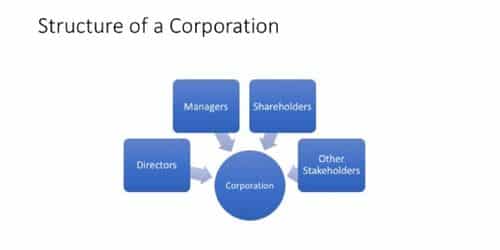The term “corporate structure” refers to the way a company’s many operational units work together in a hierarchical way. A company’s corporate structure can be very different depending on its goals and the industry in which it works. This article talks about what a corporate, business, or organizational structure is.
Business Organization: The Fundamentals
In the United States, the most common way for a company to be set up is with a board of directors and a management team. “Corporate structure” is a term for how a business is run, but “corporate governance” is a more common term. Corporations have structures like
#1. Directors’ Board
There are two kinds of directors that the shareholders choose to serve on the board. The first group is made up of directors who are chosen from within the organization. However, this could be the company’s CEO, CFO, manager, or any other employee.
The other type of representation comes from people outside the company who want to be directors. The shareholders, who are represented by the board of directors, are in charge of keeping an eye on how the company is run. However, the main job of the board of directors is to keep the company’s stockholders safe.
More Information on Business Organizational Corporate Structure
Board members can be put into three following categories:
- Chair: The board chair is the real leader of the company and is responsible for making sure it runs well. However, board members usually have to communicate well with the CEO and other top executives, set the strategic direction of the company, act as a link between the board and the public and shareholders, and protect the company’s reputation. Also, the chair of the board of directors is chosen from among the members of the board.
- Inside leaders: These directors are in charge of giving the go-ahead to the company’s most important initiatives and projects and checking out the strategic plans of higher management. Insiders on the board of directors are usually shareholders or senior executives who have a stake in the company. However, directors who already work for the company can give the board important information from the inside. When these people are part of the management team of a company, they are called “executive directors.”
- Directorship from the outside: Outside directors are not part of the management team, but they share the same responsibilities as the inside directors in setting the company’s strategic direction and policy. Also, having outside directors ensures that the board will hear from a variety of viewpoints on any given issue.
#2. Management Team
The other level is the company’s management team, which is in charge of running the business day-to-day and making sure it makes money.
Chairman of the Board and CEO: CEOs are often the highest-ranking executives in a company, and they report to the chair and the board of directors. However, the CEO is in charge of making sure that the company’s strategic plan is carried out, that new ideas approved by the board are put into action, and that, with the help of the other members of management, the company runs smoothly.
Most of the time, the chief executive officer (CEO) is also the president of the company. This makes him or her an inside director (if not the chair). It is, however, suggested that the CEO of a company not also be its chairperson. This also helps keep the chairperson’s independence and makes sure everyone knows who is responsible for what.
The COO is in charge of the day-to-day running of the company. This also includes HR, finance, IT, and manufacturing. However, the COO is in charge of day-to-day operations and gives the CEO advice. Often, the COO is more hands-on than the CEO. A senior vice president is often a chief operating officer (COO).
The CFO reports directly to the CEO and is in charge of all financial matters, such as analyzing and reporting financial data, making budgets, and keeping costs in check.
The Chief Financial Officer must share this information with shareholders and government agencies like the Securities and Exchange Commission. He or she must also share it with the Board of Directors on a regular basis (SEC). The chief financial officer, or CFO, is a top manager who is in charge of a company’s finances.
Organizational Corporate Structure
When it comes to running a business, everything depends on how the organization is set up. It also says how information is shared between the different levels of management. All businesses have the same structure, from the smallest one-person business to the largest multinational corporation.
The corporate organizational structure of businesses also affects how information moves from one level of management to the next. In a centralized structure, for example, most of the power is at the top, where decisions are made. In a decentralized structure, on the other hand, power is spread out among a number of departments or divisions. Businesses can keep working well and staying focused if they have a strong framework in place.
Types of Organizational Structure
The following types are organizational corporate structure firms below:
#1. Departmental Organization
This system sorts business operations by market, product, or type of customer. However, the purpose of the organizational structure is to make it easier to put together teams that can copy the work of certain divisions to meet the needs of those divisions. Geographical structures, in which different divisions are set up to serve different regions, and functional structures, in which different departments specialize in different parts of the production or delivery process, are two common types of divisional structures.
#2. Structural Matrix
The matrix structure is an organizational model that combines the functional and divisional models. However, lower levels of management can make decisions, employees have more freedom to make their own decisions, and there are more chances for departments to work together. Even though this way of organizing a business has many benefits, it is more expensive and can cause problems between vertical activities and horizontal product lines.
#3. Hybrid Framework
Like the matrix, the hybrid structure combines functional and divisional organization. A traditional grid structure isn’t used in a hybrid structure. Instead, it uses functional and/or divisional departments to reach its goals. This organization is set up so that each department can focus on its own products while making the most of the resources it has. This way, everyone can work as efficiently as possible. However, the hybrid structure is now being used by a lot of multinational companies.
#4. Organized Purpose
In this way of setting up the business, workers with similar tasks and skills are put in the same sections. However, this makes it easier for people in a department to talk to each other, which makes it easier for people to make quick, well-thought-out decisions. In business, a functional organization looks like a company that has separate departments for things like IT and accounting.
Business Corporate Structure
The organizational structure of a company shows who owns what, how the money is split, and who does what at the top. Depending on how the company is set up, the tax liability of the business and the liability of its managers and owners in case of wrongdoing or a lawsuit will be different.
Types of business structure
The following are the types of organizational or business corporate structure below:
#1. Company With Limited Liability
A sole proprietorship is a business in which the same person owns and runs the business. “Single trader,” “individual entrepreneurship,” and “proprietorship” are some other names for this type of business structure. However, in the eyes of the law, the owner and the business are the same things. Also, a sole proprietorship is a type of business where the owner makes all the decisions and doesn’t have to hire any workers.
#2. Partnership
In a partnership, two or more people work together to own a business. The partners share profits and losses equally, and they are both responsible for running the business. Partners get profits that can be shared, and they can deduct those profits from their own tax returns. Unlike corporations, a partnership’s income and expenses are taxed as if they came from a single entity.
#3. Corporations That Can’t Be Sued Easily
A limited liability company (LLC) is a type of business structure where the company and its shareholders are treated as separate legal entities. Also, limited liability companies (LLCs) are a type of business structure where the owners’ liability is limited to the amount of money they put into the business (the shareholders).
What Is a Corporate Structure
Simply put, a company’s corporate structure is the way that its different departments, divisions, and job positions work together to reach the company’s goals. Establishing clear lines of communication and authority is important for the smooth running of any business. Usually, this kind of structure is needed to make sure that important tasks are done in line with the company’s values. Even the smallest organizations have a formal organizational structure, even if it’s not very complicated.
Most of the time, a formal company structure makes it easier to reach three goals. First, the organization’s structure makes it clear who is in charge of what in the business. However, most people agree that the accounting department is in charge of the company’s finances and sending out invoices for goods and services. The sales team’s job is to let people know about the company’s products and services. It is common for the structure to include provisions for executive, management, and administrative problems so that everyone in the organization knows who to talk to about a certain problem.
The corporate structure also helps set up a chain of command that works. It is common for a company to assign responsible people at different points in its structure to make sure that tasks are done correctly and according to the company’s rules. It gives the company a system of checks and balances by giving different levels of responsibility to different people within the corporate structure and holding those people accountable to each other for how well they carry out that authority. If an employee is unhappy with their direct manager, a higher-up will listen to their concerns and, if necessary, take over that person’s duties.
Why Is It Important to Have a Good Corporate Structure in Place When Doing Business These Days?
In a corporate structure document, business goals and strategies can be written down, as well as the history of the company.
- Think about how much power you have over your affiliates and how they relate to each other in different countries.
- Make short-term and long-term plans for all of your company’s jurisdictions based on its goals and objectives. Think about how the different parts of your company’s business have affected its growth.
- Find out who in your company is in charge and what they do.
Pros of Corporate Structure
The following are the advantages of an organizational or a business corporate structure below;
- Compare your company’s past growth, product lines, target markets, and geographic reach to those of your competitors.
- Make your organization more open by writing down how the different departments depend on each other and what the top management’s jobs are.
- If the company’s policies, methods, and procedures are clear, you can trust the decisions it makes.
- Analyzing the company’s current goals, resources, and potential is one way to improve business results.
- Tell each employee what their specific jobs are and how their work will be measured.
Cons of Corporate Structure
The following are the disadvantages of an organizational or a business corporate structure below;
- Growth potential is limited by a lack of knowledge about the market and how to divide customers into groups.
- Operations are being stopped with unclear obligations.
- Lack of speed in making decisions because of a lack of understanding of how the parent and subsidiary relationship works and how much oversight should be done.
What Is an Example of a Corporate Structure?
In the United States, the most common way for a company to be set up is with a board of directors and a management team. Most boards of directors have both internal directors who have worked in the company’s day-to-day operations and independent outside directors who can offer valuable insight.
What Are the 3 Basic Corporate Structures?
Even though there are many different types of corporate structures, every successful business has a board of directors, a management team, and shareholders.
What Are the 4 Types of Organizational Structures?
There are four main types of organizations: functional structures, structures with many divisions, flat structures, and matrix structures. Aside from these, there are also ones that are based on teams or networks.
What Is the Purpose of the Corporate Structure?
The structure of an organization should make it easier to reach its goals and make sure that its departments and processes work well. By giving people jobs and roles, organizational structures help management coordinate and keep track of what’s going on.
What Is a Corporate Structure Called?
The structure of an organization is a diagram that shows how its departments, divisions, and staff positions fit together. The structure of an organization shows employees what their jobs are, who they report to, and how decisions are made.
Conclusion
Choosing the right business structure is an important part of incorporating a company because it lets the business be recognized legally and sets rules for how it will run. The way a company is set up shows how well it does business.
Corporate Structure FAQs
What factors into a company's structure?
- How comfortable are you with taking risks that could negatively affect your financial security?
- The IRS will tax business income in accordance with your preferences.
- In what ways do you envision a more rigid organizational structure?
- How much bureaucratic muddle can you handle?
- When thinking about the company’s future, what are your hopes and dreams?
What are the components of structure?
Job descriptions, division of labor, delegation, reporting relationships, and a hierarchy are all components of an organization’s structure. In combination, these make up the framework of each given organization’s chart.
What is the best way to set up a business?
Most businesses, especially smaller ones that don’t have a lot of moving parts and don’t need a complicated chain of command, function best with a traditional line organizational structure.
Related Articles
- CORPORATE STRUCTURE EXAMPLE: Meaning, Examples & Difference
- Business Structure: Meaning, Types, Examples & All You Need
- CORPORATE RECORD BOOK: Meaning, Importance & How to Get It
- Business Structures: Different Types of Business Structures Explained
- SALES COMMISSION STRUCTURE: 2022 Templates & Examples
- WHAT IS LIVE STREAMING: How to Watch It, It’s Shopping and Dangers.
- What Is Inc: What You Must Know, Difference, & File.






